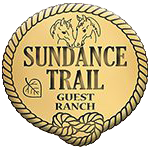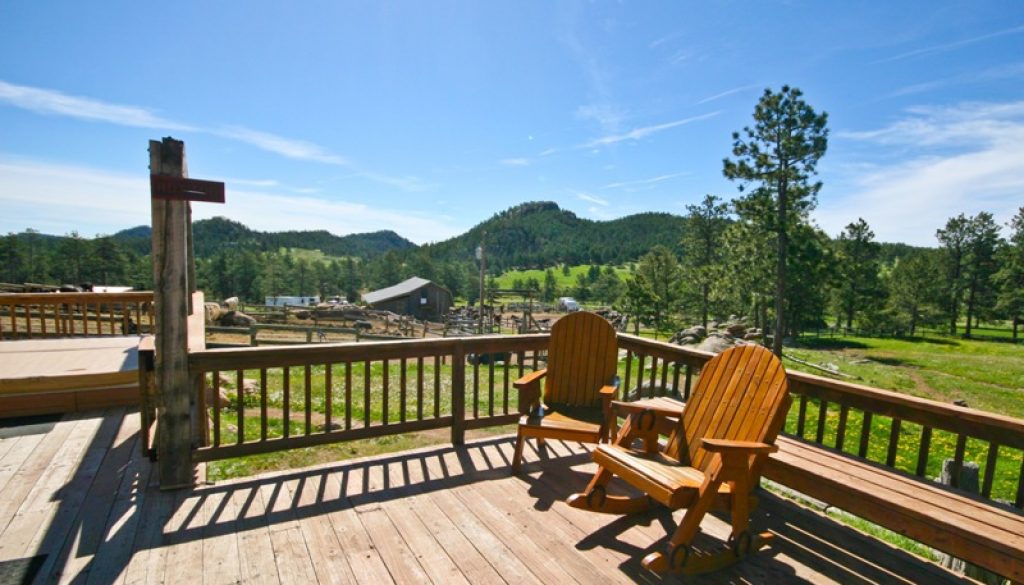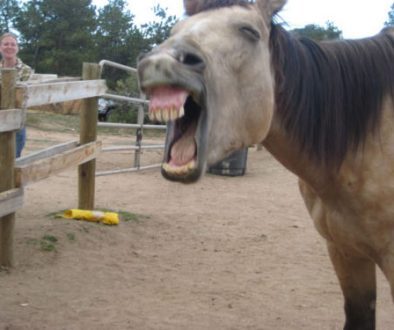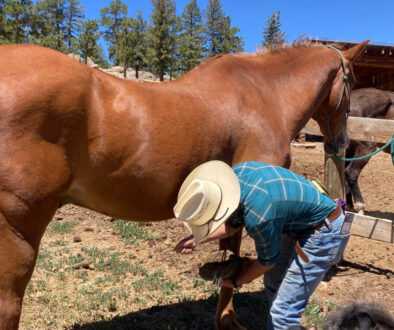The New Dude (Outside Traveler Magazine) By Tim Brooks, Family Edition 2003
The New Dude ( Outside Traveler Magazine)
By Tim Brooks, Family Edition 2003
“HORSES ARE AFRAID OF TWO THINGS,” Dan Morin explained, taking off his Stetson and settling himself near the huge granite fireplace in the parlor of his Sundance Trail Guest Ranch. “Everything that moves and everything that doesn’t.”
Dan was giving two dozen of us dudes the introductory talk for our week at the ranch, and it wasn’t going well. The thing to remember about horses, he said, is that they are at the bottom of the food chain. Everything eats them given the chance: bobcats, wolves, lynxes, mountain lions. “Think of a horse as a very large rabbit,” he suggested, one that will select from three unpleasant responses at the first hint of danger: buck, bolt, or bite. The art of riding, therefore, seemed to consist mostly of avoiding stuff your horse might be afraid of. Yeah, yea, I thought. But what if you’re afraid of the horse?
Given that fear, it may sound odd that I brought my wife, Barbara, and seven-year-old daughter, Maddy, out from Vermont last August to spend a week at a dude ranch in Red Feather Lakes, Colorado, 37 miles northwest of Fort Collins. But the fact is that I didn’t have to spend the entire week surrounded by stampeding cattle, being yelled at by leathery wranglers, or constantly in the saddle. Sundance is a sort of multi-sport adventure center offering a hyperactive menu on top of riding hiking, rock climbing, mountain biking, fishing, whitewater rafting, four-wheeling, archery, riflery—the full western octathlon.
Besides, my wife loves riding, and she hoped Maddy would like it, too. I wanted to explore the Colorado Rockies, and I didn’t want to go on foot because, to misquote Gertrude Stein, there’s too much there, there. So we’d do it the old-fashioned way: on horseback. And that’s how—even though tall hats look silly on me and, having grown up in England, I’d already eaten enough beans for a lifetime—I started thinking about ranches.
Dude Ranch Hoof Picking – Dude ranching started to catch on in the 1850s when western farmers, always on the lookout for a second income, started hosting aristocratic adventurers from Britain, Ireland, and Russia in search of good hunting. One party in 1871, guided by Buffalo Bill Cody, shot more than 600 bison and 200 elk, and traveled the Colorado Territory with French chefs and 25 wagons, including three that served as mobile icehouses.
My favorite dude was my countrywoman Isabella Bird, who visited Colorado in 1873. She survived rattlesnakes, locusts, and ghastly frontier food (she described one entrée as “black with living, drowned, and half drowned flies”). Bird rounded up cattle and climbed Longs Peak—which at 14,255 feet was a considerable achievement, even if her detractors say that she was hauled up the difficult parts in a basket.
Today’s dude ranching is, frankly, less arduous. The Sundance Trail Lodge is a large A-frame log cabin, perhaps built by someone familiar with Architectural Digest, flanked by two smaller cabins, housing a total of 24 guests. Built in 1968, the lodge has a large dining room as well as a parlor, two guest suites, and quarters for the owners, Dan and his wife, Ellen. We stayed out back in a kind of woodsy duplex among the trees that comprised of a one-bedroom and a two-bedroom suite. Our quarters were small yet comfortable, with a shower but, thank God, no TV or telephone. Sundance is neither Old West nor new age, more like an amiable, unpretentious family home, with big picture windows and pine furniture, that happens to have a lot of land and a lot of horses.
And I mean a lot of land. The ranch is on 140 acres, surrounded by 660,000 acres of Roosevelt National Forest between the Mummy and Rawah ranges of the Rockies, a remarkable setting: yellow-gray granite hills like stacks of pancake; forest of ponderosa pine, aspen, and Norway spruce; a floor of sand, pine needles, carpet juniper, and fragments of dead branches, bleached like bones. At 8,000 feet, poisonous snakes are rare. Sundance is too high for most insects, too. Just the brilliant western sky, broad-tailed hummingbirds around the porch, cool nights, and the sighing of the wind in the pines.
Dude Ranch Day Dreams After his first-morning talk, Dan led us down to the corral, where we met the wranglers, all age 20 or 21: Dustin, Josh, Lonni (the children’s wrangler), and Rifka. All four in addition to having spent most of their lives in the saddle, were college kids working over their summer break.
“If your butt’s sore,” Dustin was saying in his droll cowboy way, “your stirrups are too long. If your knees are sore, your stirrups are too short. If both of ‘em are sore, your stirrups are about right.”
We were all quizzed about our level of horsemanship and assigned horses for the week accordingly. The more experienced dudes were eyeing lean horses distantly related to the Maserati; I was hoping for something like a 1964 Land Rover. By then all I could remember of Dan’s talk was that one end of a horse kicked and the other bit.
Sundance Trail has a stable of 21 quarter horses and leases 30 more for the summer visitors. My prospective mount, a roan named Redman, squinted at me sideways, his eyes barely open in resentful and reptilian leer. “I am not a mountain lion,” I told him. “I am not a bobcat. I am not a wolf.”
These calming words must have done the trick, for once I was up in the saddle, the ground a distant memory, Redman turned out to be amiable and touch-sensitive, if rather generous in his output of methane. By the second day I was giving him a little more than a twitch of the rein or a nudge of the heel. I realized that “ride” is used in two opposite senses: to be in charge or to give up control. When your horse is descending a steep, narrow trail, picking its way through sand and stones, you have to ride by letting go, releasing your hips to go with the horse while the rest of you remain level—like surfing from the waist down.
We graduated from one-hour rides, along the piney trails that surrounded the ranch, to three- and four-hour rides among the buttery rocks that made up the ridges. Dustin sang cowboy songs, Josh told cowboy jokes, and nobody got yelled at or stampeded. On the last day we rode out to a panoramic outdoor breakfast up on a rocky knoll, and those who were expert riders and hadn’t eaten too much galloped back. When we weren’t on horseback—and as the week went on, each family increasingly wandered from the herd—we took evening hikes to some of the surrounding outcrops, shot pool in the rec room, explored the area in the ranch’s jeep, and spent more and more time lounging around on the porch, talking more slowly.
Marshmallows Make Dude Ranch Friends!Some of the more traditional western activities were less of a hit. When we drove 15 miles downslope to the bend-in-the-road hamlet of Livermore to watch the weekly calf-roping—a strange and demanding sport—some were bemused. (“Novel concept,” observed Ken, an architect from Philadelphia.( “Recreational cattle.”) Others, like Barbara, were appalled at the squeals of the calves, rushing down the chute ahead of the cattle prods.
“You just ate beef kebab,” I pointed out.
“yes, but I didn’t play with my food,” she retorted.
The beauty of Sundance was that everyone—the adults as well as the kids, who ranged from three to 15 years old—found and fell into his or her own rhythm. The two 15-year-olds, for example, invoked the Teenager’s Bill of Rights: One was happy enough not joining in much of anything: the other made a token appearance on horseback, then spent the rest of the week rafting.
Our family found rhythms we’d never have expected. I overcame my unease around horses and my fear of heights (I thought that on rock-climbing day, they’d have to haul me up in a basket) and ended up whooping and swinging across the 60-foot rock face like Spider-Man. Yet I probably got the most pleasure from teaching Maddy and her new friends Faye, 9, Kirk, 10, and Patrick, 11, how to play cricket with a branch and a pine cone, a multicultural sporting feat beyond even Isabella Bird.
Barbara followed Maddy over to the rifle range—a couple of shelves of tin cans set up in the trees—and, to her own amazement, turned out to be a markswoman.
Dude Ranch BreakfastMaddy, surrounded by so much that was new, never became entirely comfortable on a horse and balked at the rock face, but found her own fun, hiking and clambering up the boulders around the ranch with the younger kids, in pursuit of a dozen cats. No one suspected that her favorite day would turn out to be the afternoon we spent whitewater rafting.
Even though the Cache La Poudre River, normally Class III and IV, was so low that August that we could have hopped out and walked—and our guide from Rocky Mountain adventures did, whenever we ran onto rocks—we all paddled hard screamed harder, and spun downstream. When the five-mile outing was over, Maddy and I fell out of the raft and floated around in our life jackets.
“Can we do it again?” She asked, and she’s still asking.




